Mexico is the capital of delicious and spicy food! It has beautiful and historic places to visit and wonderful people. It also happens to be a dog-friendly country. A census provided by the Mexican Institute of National Geography (INEGI in Spanish) revealed that 89% of Mexican pets… are dogs!
Here at Pet Comments, we’ll tell you about 3 dog breeds recognized to be 100% Mexican and other dog breeds that are popular in the land of the chili pepper and dog lovers.
Dog Breeds Native to Mexico
The Mexican Canophile Federation recognizes the following dog breeds to be native from Mexico.
Chihuahua
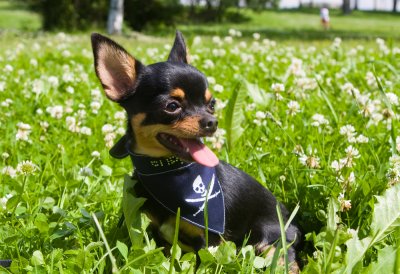
Chihuahuas are native from the Mexican State of the same name. A theory states that the Chihuahuas descend from the Teichichis. A dog breed that was kept by the Toltec, a civilization that preceded the Aztecs. They believed that these dogs guided the souls of diseased people through the afterlife; because of this, Chihuahuas were sacrificed in the process. Making the Chihuahua a very old dog breed with an interesting backstory.
Chihuahuas love to have the company of their owners. With their small size and big attitudes, Chihuahuas are playful and love to be the center of the universe. This dog’s loyalty towards their owners is unbreakable and their attractive appearance cannot go amiss. Not minding their size, Chihuahuas can be snappy to both children and unknown people. They tend to be dominant and aggressive, but introducing them to positive social interactions and good training can diminish these negative traits.
- Height:15 - 23cm
- Weight: 1 - 3kg
- Personality: Chihuahuas have an energetic personality. They bark a lot, however, they are intelligent dogs, temperamental at times, but full with empathy and loyalty.
- Coat: They present two types of coats. Smooth and longhaired, and they can also be found in a wide variety of colors.
- Activity Level: This dog is always alert and full of energy. Despite this, it has low exercise needs. It does need plenty of human interaction though.
Fun Fact: They are considered to be the smallest dog breed. Also called Teacup, Chi, and Chihauhau. According to a census provided by the DogHero app, they were the second most popular dog breed in Puebla, Guadalajara, and the city of Mexico.
Calupoh or Mexican Wolf-Dog
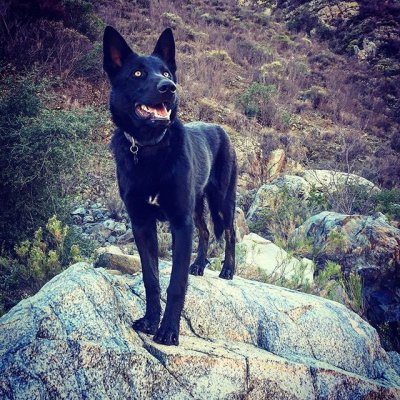
Calupoh, also known as the Mexican wolf-dog, comes from a hybrid cross between the common dog and the Mexican gray wolf. Its reproduction was rescued because the remains of this type of dog were found in several ancient sacred temples, which showed that they had an important spiritual meaning during different rituals. The first Calupoh exemplar was identified in 1999, therefore, it is a rather young dog breed.
It’s an agile, large, and strong dog. Their eyes are mostly yellow or dark brown in some cases due to their dog heritage. Today, Mexicans consider them a working dog breed capable of learning different activities. They are noble and caring towards their family, but can be distrustful towards unknown people. Native from Mexico, this dog’s wolf-like appearance catches both people’s attention and hearts.
- Height: 62 - 75cm
- Personality: They are noble, devoted towards their families, and sociable with other dogs.
- Coat: Their coat is medium-long with a rough texture on the outside. Their coat is mostly black, but some older dogs’ coats tend to become silver.
- Activity Level: Needs daily physical activity, and is a dog very adaptable to the owner.
Fun Fact: Is estimatedthis dog and the wolf hybrid both appeared about 1500 years ago; thus, like other Mexican dog breeds, it has an ancient history.
Xoloitzcuintli
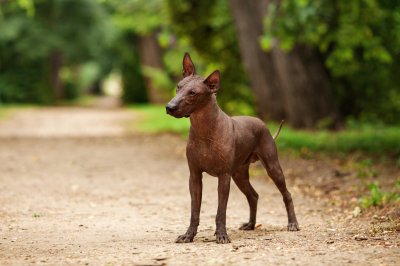
There have been dog skulls found that resemble this dog’s size and breed that date to back 3300 years ago in Central America; which makes the Xoloitzcuintli a living fossil of sorts. This archaeological discovery reveals that the Aztecs considered these dogs the living representation of the god “Xolotl”. They believed that they possessed healing powers, and like the Chihuahua, they guided the dead through the afterlife.
Being a 100% native from Mexico, this archeological jewel is commonly called “Xolo” by its people. It has a compact and muscular body, and it is perfect for families. Because it is naturally attentive and courageous, it makes a good watchdog. Xolos are only suitable as indoor pets, because of their lack of hair they cannot spend too much time outdoors. Xolos are playful and good with children, but because of their delicate skin, children have to be careful not to injure the dog.
- Height: The Xoloitzcuintli dog breed has three variants of height. Toy: 28 - 31cm, miniature: 30 - 38cm, standard: 41 - 57cm
- Weight: The Xoloitzcuintli dog breed has three variants of weight. Toy: 4 - 8kg, miniature: 6 - 10kg, standard: 10 - 14kg
- Personality: Intelligent, playful and a loyal companion. It can be distrustful to unknown people. Xolos don’t like to be alone.
- Coat: The Xoloitzcuintli comes in two varieties: Hairless and Powder Puff. The Power Puff color version includes orange, black, slate, bronze, and charcoal.
- Activity Level: Low exercise needs.
Fun Fact: A Xoloitzcuintli named “Dante” is the first dog of this breed to be part of the Mexican Federal Police canine unit. It was donated by the Mexican Canophile Federation in 2017.
Dog Breeds Popular in Mexico
The following is a list of dog breeds that are not native to Mexico, but Mexican people cannot have enough of them!
Schnauzer
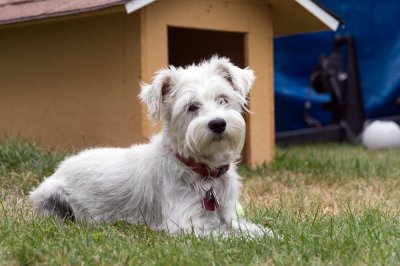
The third most popular dog breed in Mexico City, Puebla, and Guadalajara is the Schnauzer. It is estimated that the Schnauzer originated in southern Germany, probably between the XIV and XV centuries. Originally used as a working dog, this canine of very dignified bearing accompanied farmers, traders and protected their loads from mice and other pests. Although they were originally developed as a working dog, the Schnauzer proved its worth as a companion dog, raising its popularity as the favorite of many families with children.
The Schnauzer dog requires daily doses of exercise. It is a dog willing to run, walk, play, and is very intelligent so it also enjoys puzzles. Because of this, they cannot get bored or be alone for a long time without the company of his owners; otherwise, they can develop destructive behaviors. This mustached buddy has natural hunting instincts because of their past as a mouse-hunter. Perfect for taking care of the family, as they are excellent guard dogs.
- Height: The Schnauzer dog breed has three variants of height. Miniature: 30 - 36cm, standard: 41 - 50cm, giant: 58 - 71cm
- Weight: The Schnauzer dog breed has three variants of weight. Miniature: 5 - 7kg, standard: 14 - 20kg, giant: 25 - 48kg
- Personality: It has a strong temperament, so it needs firm but loving education early on.
- Coat: Their coat remains the same in the 3 varieties of Schnauzer. They have two layers of hair. The inner layer is soft and spongy, and the outer layer is rough to the touch. The most common color is salt and pepper, but they may have other color combinations; like black and silver, solid black, solid white, gray and white, and black and white.
- Activity Level: Moderate. It needs time to exercise the mind and body. Can develop self-destructive tendencies if left alone too long.
Fun fact: The name comes from the German word "schnauze", which means “muzzle”, and refers to the funny whiskers that stand out on the face of this dog.
Pug

Another dog breed Mexicans feel more inclined to own is the likable Pug. They are the third most popular dog breed in Monterrey, Mexico, after the Yorkshire and mixed-race dogs. Probably originated in China, this dog breed’s roots go back to 400 B.C. Unlike other dog breeds in this list, the Pug was not bred as a working dog (or as a sacrifice to the gods). They were bred to be companion pets. They were used as company dogs and lap dogs for Chinese emperors, royalty, and wealthy people in general. Not a rough beginning at all.
One of the reasons families prefers the Pug dog breed is their low need for exercise. Pugs are more than willing to be lazy with you all day long. Unfortunately, this can lead them to suffer from obesity. To fight this tendency, kind owners will spend a reasonable time playing with them outside, or taking them for a walk.
- Height: 25 - 36cm
- Weight: 6 - 8kg
- Personality: Pugs have a laydown personality, but they are eager to please their owners and spend time with them.
- Coat: They have short, flat hair. Most Pugs have a mask on their muzzle of a black color, and their ears are also black. The rest of their body is fawn, silvered fawn, or apricot, but they can also be completely black.
- Activity Level: They don’t need too much activity, but at least 20 minutes of exercise is recommended.
Fun fact: In 1572 in Holland, a Pug alarmed Prince William that the Spanish soldiers were approaching, saving his life in the process. For this reason, the breed was forever tied to the Royal House of Orange and is a popular dog breed in the country.
Yorkshire Terrier
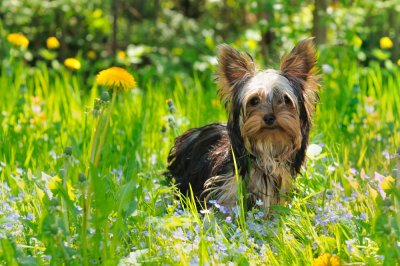
Another favorite of Mexicans is the Yorkshire terrier, so much that they are the most popular dog breed in Monterrey, Mexico. Its small size makes them the perfect pet for home. Like their name states, they were developed in Yorkshire County, England in the XIX century. Theories go that Yorkies descend from terriers and were developed at first to catch rats, badgers, and fox burrows. As a result, even today Yorkies have a strong hunting instinct. The AKC has officially recognized them since 1885.
The Yorkshire terrier has two types of coat, silky and cotton. A major difference between them and other dog breeds is their coat, Yorkies have a coat of hair and not of fur. This means their hair grows much longer than other dogs, which requires constant trimming. They don’t shed too much and their coat is less dense than other dogs. In essence, if you want your Yorkie to have a catwalk-look, prepare to spend plenty of time and effort on this little diva’s appearance.
- Height: 20 - 23cm
- Weight: 2 - 3kg
- Personality: Energetic and dominant. They tend to bark and be aggressive with children and strangers, but can be corrected through training.
- Coat: They have two types of coat. Silky and cotton. Silky Hair is glossy, fine and silky in texture. The cotton-type of coat is much thicker, and it doesn’t grow as long as the silky type.
- Activity Level: They require at least 20 minutes of daily exercise appropriate for their size.
Fun fact: A Yorkie named "Smoky" was a well-known hero during World War II. A soldier named Bill Wynne adopted her. After the war, she became the first therapy dog in history. She died in 1957 and a monument was built in her honor.
Labrador Retriever
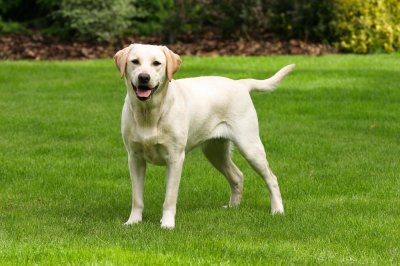
The Labrador retriever is the pet of choice in many homes in the United States, and is one of the favorites in the rest of the world, including Mexico. Its origin dates back to the early 1800s in Newfoundland, Canada where they were already known companions of fishermen. Their job was to catch the stragglers that escaped the fishermen's nets. By the XIX century, British breeders had already refined and standardized the breed.
The skills of the Labrador retriever make them deserving of a spot in human society. Today they are known for being the most used dog breed for therapy or as service dogs. They are devoted companions who need to be part of every activity. Their friendly character with people, children, and even other dogs making them the most popular dog for families for decades.
- Weight: 25 - 36kg
- Personality: A faithful and compassionate dog, calm and sociable, both with other animals and with people.
- Coat: Short, thick and abundant. They have three main colors: cream, chocolate, or black. They need to be combed frequently to diminish shedding.
- Activity Level: They need large doses of physical activity, as they are dogs bred for hard work and energetic activities.
Fun fact: A Labrador retriever named “Frida” helped locate more than 52 people after Mexico’s devastating earthquake in 2017. She belongs to the Mexican Navy’s canine unit.
English Bulldog
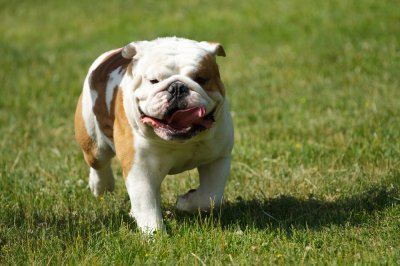
This sweet boy of rough appearance was the center of attention in 2017. It was the date when Mexico hosted the English Bulldog World Championship. The English bulldog has a somewhat dark past because in its beginnings it was used for a bloody sport. Evidence suggests that they originated in the XIII century for the "sport" of bull-baiting. Where a bull was tied and dogs were released to fiercely attack the bull. In 1835, this "sport" was banned, which brought the bulldog very close to extinction.
Lovers of the breed gave themselves the work of recovering and "improving" the breed to make it less aggressive and more attractive as a companion pet to the family. Nowadays bulldogs are the armchair companions of many families and the national symbol of England. They are friendly dogs who enjoy pleasing their owners. They love to play tug-of-war, but they have to be trained to release what they have in their mouths, and they love to chew, thus chewy toys are their favorite.
- Height: 35.5 - 38cm
- Weight: 18 - 22kg
- Personality: Friendly and eager to please their owners. They can be aggressive and protective of their food if not trained since young.
- Coat: Short, sleek and coarse. It does not require much maintenance. They have different coat colors, mainly: fawn, red, white, piebald, and brindle. The AKC standard allows for many different coat colors besides for merle.
- Activity Level: Moderate. It does need at least 20 minutes of daily exercise.
Fun fact: The word “bull” appears in bulldog because of their past as bull-baiters, a sport that is now very illegal.
The Chinese Crested
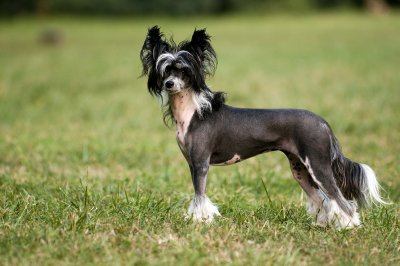
Before anything, no the Chinese Crested dogs do not come from China.
The origin of the Chinese Crested is still unclear. It is theorized that they descend from African hairless dogs that merchants took to China where they reduced the size of the breed with crosses. Merchant ships from China traveled to the rest of the world with Chinese Crested dogs on board as they were useful for hunting mice and other vermin that were on the ships. The sailors exchanged them in the ports, and this is how they arrived in different parts of the world.
An interesting fact that connects the Chinese Crested with the Xoloitzcuintli,is that both dog breeds share the same mutation that determines the baldness of their breeds. Although the origin of the Chinese Crested is not known with certainty, it is not so mistaken to suppose that Latin America is an option. Since other hairless dog breeds also come from there, like the Xoloitzcuintli and the bald Peruvian dog.
Their lack of fur makes them a warm lap mate that provides warmth on the coldest days. They have a loving and cheerful personality and don’t bark much.
The Chinese Crested has two varieties: the hairless and the powderpuff. The hairless variety requires more care. They should be bathed frequently and not exposed to the sun.
- Height: 15 - 35cm
- Weight: 3 - 10kg
- Personality: Friendly and sociable personality. It can get along well with people and other pets.
- Coat: It has two varieties. The variety without hair is almost hairless, except for the hair on their head, tail, and paws. In addition, the powderpuff is completely covered with long, fine hair.
- Activity Level: It is not an athletic dog but needs at least 20 minutes of exercise daily.
Fun Fact: “Sam” was a Chinese Crested that won the “World’s Ugliest Dog” title three times in a row.
German Shepherd
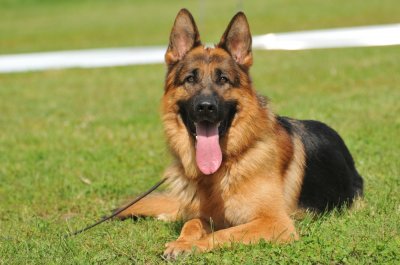
Police and guard dogs by nature,this canine breed is present in all parts of the world for his innate abilities and many skills. It was bred in Southern Germany as a product of different mixtures of dogs for grazing. It was not until 1899 that Max Von Stephanitz, captain of the cavalry, standardized the breed to achieve the specimen of the German shepherd that is known today.
It has a calm personality, transmits security, and confidence. It is a dog distrustful of strangers, but not aggressive by nature. It is always alert to any threat and acts quickly, and as a result, it is requested in many jobs as a watchdog. To avoid problems such as excessive aggressiveness as an adult, the dog must be socialized appropriately when it is a puppy. It is also a good playmate for children, but sometimes they do not know their own strength.
- Height: 55 - 65cm
- Weight: 25 - 40kg
- Personality: Calm, protective, but distrustful of strangers. They must be vigilant but not aggressive.
- Coat: Black and tan, black and red, black and silver, bi-color, and black and sable. They can also be found in white, liver, panda, and blue, but the last three are not accepted in competitions.
- Activity Level: High activity levels. They need to stay busy.
Fun fact: "Ecko" and "Evil" are two German shepherd brothers who helped in the rescue of survivors of the 2017 earthquake in Mexico. Both are part of the canine unit of the Mexican Navy. They work together and are inseparable. Their history was shared through social networks.
Conclusion
Finally, each zone and culture has a preferred pet. Perhaps the preferred dog breed in your area is different from the Mexican preferences. One thing is for sure, whether you want a playmate for your children, an adventure companion, or a brave guard dog; you'll find the right one for your circumstances in a loyal canine.
Further reading and references:
- https://twitter.com/robertoah/status/1090236253939871745 (DogHero census of the most popular dog breeds in Mexico)
- https://www.milenio.com/estilo/tu-mascota/viva-mexico-caninos. (MILENIO Mexican Newspaper, only 3 dog breeds are recognized as 100% Mexican by the Mexican Canophile Federation)
- Wikipedia. Dog breeds originating in Mexico